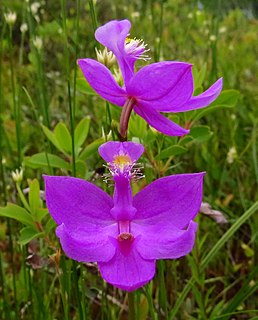
Pediocactus is a genus of cacti. The genus comprises between 6 and 11 species, depending upon the authority. Species of this genus are referred to as hedgehog cacti, though that name is also applied to plants from the genera Echinocereus and Echinopsis. Species may also be referred to as pincushion cacti, a common name which is also applied to other genera.

Harrisia is a genus of night blooming cacti native to Argentina, Paraguay, Brazil, Bolivia, Uruguay, the Greater Antilles, the Bahamas, and the U.S. state of Florida. The genus is named after William Harris, an important botanist of Jamaica. There are about 20 species.

Calopogon tuberosus, the tuberous grass pink, is an orchid native to eastern North America.

Pediocactus winkleri, commonly known as Winkler's cactus or Winkler's pincushion cactus, is a small cactus endemic to the state of Utah in the United States. It is known only from Emery and Wayne Counties.

Trichocereeae is a tribe of cactus that are particular to South America. There are 25 recognized genera in this tribe.
Juttadinteria simpsonii is a species of plant in the family Aizoaceae. It is endemic to Namibia. Its natural habitats are rocky areas and cold desert. It is threatened by habitat loss.

Silphium asteriscus, commonly called starry rosinweed, is an herbaceous plant in the family Asteraceae. It is native to the eastern United States, from Oklahoma and Texas east to Florida and Pennsylvania. It is a widespread species found in a variety of open habitats, such as prairies and woodlands.

Harrisia aboriginum, the prickly applecactus, is a species of cactus endemic to peninsular Florida, on the Gulf Coast of the counties of Lee, Sarasota County, and Charlotte. Only 12 occurrences are known, and the species is threatened by horticultural collection, shading from fire suppression, competition from invasive flora, and habitat destruction.

Harrisia bonplandii is a species of cactus. The cactus plants in the Gran Chaco are generally called tuna and this specific variety reina de la noche. Fruits and roots are edible and well known to the native nations of the Gran Chaco.

Harrisia divaricata is a species of cactus endemic to Hispaniola.

Harrisia fragrans is a rare species of cactus known by the common name fragrant prickly apple. It is endemic to Florida, where it is known only from St. Lucie County. The plant's habitat has been almost completely consumed by development, leading to its rarity. It is a federally listed endangered species of the United States.

Harrisia martinii, commonly called the Martin applecactus, is a species of night-blooming, rope-like cacti native to South America. With large showy flowers that attract the hawk moth, it is considered by some a useful landscape plant in areas that do not freeze.

Harrisia pomanensis is a species of cactus.
Harrisia is the name of two genera of life forms:

Pereskia aculeata is a scrambling shrub in the family Cactaceae. Common names include Barbados gooseberry, blade-apple cactus, leaf cactus, rose cactus, and lemonvine. It is native to tropical America. The leaves and fruits are edible, containing high quantities of protein, iron and other nutrients, and it is a popular vegetable in parts of the Brazilian state of Minas Gerais under the name of ora-pro-nóbis.

Pediocactus knowltonii is a rare species of cactus known by the common names Knowlton's miniature cactus, Knowlton's pincushion cactus, and Knowlton's minute cactus.
Harrisia tortuosa is a species of cactus in the Trichocereeae tribe.
George Simpson (1880–1952) was a New Zealand naturalist and botanist. He was born in Dunedin, the son of a master builder. He, too, became a builder and valuer, working as Crown Valuer from about 1943 until early 1950. However, he, together with John Scott Simpson, became interested in collecting and growing New Zealand native plants and by 1925 both were well known within the New Zealand botanical community.
Cyperus simpsonii is a species of sedge that is native to parts of Africa.













